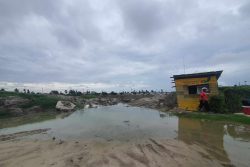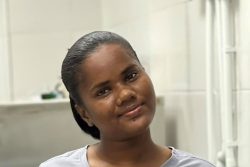Dear Editor
I have noted with interest that Guyana has been tasked with spearheading CARICOM’s drive to reduce food imports by 25% by the year 2025. Since I had previously been involved in initiating strategic food import replacement to the extent of having undertaken the corporate responsibility of promoting and developing GuySuCo’s erstwhile diversified crops, I felt I should offer, for what it is worth, the benefit of my knowledge and experience in this apparent ill-conceived activity, which needless to say, hindsight has proven and is now showing otherwise. There is no doubt that the four imported commodities recently mentioned by the Minister of Agriculture – onions, wheat, corn and soya – are candidates for
successful replacement by equivalent indigenous production. However, I am not at all sure that the replacement level envisaged in the time scale indicated is pragmatic, certainly not for Guyana or the other south and east Caribbean territories. There are a number of imponderables to achieving the goal in the short or even medium term and are briefly pointed out as follows:
1. Although there is a good deal of verifiable information on local onion production, the same is not true for wheat, corn and soya on the same scale. Considerable research is still needed in Guyana to establish suitable geographical-tolerant varieties, best cultural practices and effective pest/disease control measures for even semi-commercial production. Appropriate experienced technical personnel and state-of-the-art equipment will be required to conduct relevant research on an urgent and sustained basis. It is likely that there have been recent advances in conclusive local experimentation, so far unpublished, of which I am unaware. Should that be the case, then we are well on our way towards quick decisive semi-commercial production. Thereafter, not the least difficulty will be the establishment of a reliable system of self-generating plant seed material in increasing quantities to sustain required levels of commercial production.
2. Except for onions which at a pinch can be commercially grown under greenhouse conditions to protect against the vagaries of the weather on the coast and to some extent the intermediate savannahs, sustained favourable weather for land preparation/planting, maturation and harvesting of the GRAIN crops of interest will be at best a hit-or-miss scenario. There will at times be suitable weather for all or most operations and a complete disaster at other times as has been found in the past. Appropriate drainage and irrigation technology can be applied in the savannahs even though the weather in that terrain is generally predictable, but it is an environment in which the practice is more applicable for optimal productivity. Nevertheless, before its practical adoption technical evaluation will be required, probably with support from international expertise. Of course, adequate available funding can help to circumvent these obstacles and once the political will prevails, unwavering persistence will in the end bring the desired results. However work on the early establishment of a modus operandi must be completed in a given time frame.
3. Large scale cultivation of onions will thrive on the sandy soils of the intermediate savannahs but will also be tolerant of some soil types in the coastal belt. However, the best soil type for cultivating the chosen grain crop is undoubtedly the free draining relatively elevated intermediate savannahs, once the infrastructure and other logistics are in place by land or water for getting the agricultural inputs in, and bringing the crops out to the coast for best storage, processing and distribution.
Although livestock products were not included in the list of regional imports identified for import replacement, in spite of their substantial contribution to the food import bill, animal livestock in Guyana has the potential for development to supply the largely tourist driven regional market, once the unfounded mythical preference for grain-fed beef is dispelled. I am unsure of the capacity of the Caribbean islands (except of course the mainland Belize and Suriname) to mount an indigenous production of locally sustained livestock, an inability which if confirmed, may have led to the exclusions of imported livestock as candidates for import reduction. The major obstacle to rapidly generating animal units for livestock production is the limited reproductive capability of bovine animals, in spite of modern technology of Artificial Insemination and tissue culture. Other factors being equal, there are practical limits to large scale importation of mature animals needed for increasing stock. When combined with loss in productivity during the period required for environmental adaptation and the inevitable natural losses by attrition, the physical limitation to herd expansion is multiplied.
However, bovine and dairy livestock in Guyana offers the best economic prospects in the medium to long term for replacing extra-regional imports of beef and dairy products, provided supplies of forage and other locally available feed, as well as the support of capable livestock management is not in any way limiting. The other questions which in the past have stymied intra-regional exports from Guyana are apparent fear of disease contamination, generally unfounded, as well as the absence of an internationally approved and established abattoirs. The disease resistant/tolerant breeds originally from the Asian sub-continent, and the high producing breed resource from the US and the UK, comprising respectively Zebu/Sahiwal on the one hand and Holstein-Friesian stock on the other hand, are already in the genetic composition of coastal cattle. However, the high productivity potential of dairy and beef breeds can be expressed only through good, adequate feed nutrition and sound management practices. These days, beef converted from essentially grass-fed cattle is considered generally healthier for human consumption than grain derived beef. There is undoubtedly an abundance of pasturage and available forage in Guyana, not excluding the coastal regions and around waterways even in the near urban areas. The presence of the prolific growing antelope grass well adapted to the generally moister conditions on the coast will be the main fodder source if properly managed by selective grazing and harvesting for best regrowth.
In order to generate optimal benefit from evidently excess availability, the well documented ensiling of grass and inter-cropped leafy legumes, machine harvested from non-grazed areas must be adopted as standard practice. This strategy will provide adequate animal nutrition on a continuous “ad lib” feeding basis for achieving optimal meat and milk conversion, moreso if enriched through natural fertilizing or applied fertilizers. Grass fodder must be treated as a substantive crop that will conform to the standard cycle of land preparation, rotating areas suitable for grazing with other areas kept for silage reaping as required. There is as well a known strategy previously employed in Zimbabwe and other countries, of establishing dedicated animal fattening units to which young and other older under-nourished animals are fed “ad-libin feedlots “ on high nutrition feed to accelerate finishing weights. Indeed “Fattening Units” can be established as specialized permanent buildings and facilities. In this regard, apart from providing zero-grazing fodder and enriched silage in permanent feedlots, the use of young cane tops mixed with molasses is worthy of note – another good reason for sustaining our existing cane industry. Estate cattle farmers and the cattle themselves are aware of the feed value of young cane even as some estate management continually strove in the past to protect vulnerable cane fields from wanton cattle damage. Purposeful use of cane in an extensive organized manner as animal feed supplementation can have important economic benefits.
My reason for including cattle farming, and by extension sheep and goats, in this discussion is the contribution meat and dairy products play in foreign food imports in the region. A good deal of the imported beef and dairy products is tourist-industry driven, pertinent to the Caribbean islands mainly, but with the lifting of certain apparent animal health restrictions, Guyana could become a major intra-regional meat supplier. In conclusion, with the current food imports bill of the Caribbean approaching US$4B and the target for reduction set by the heads of Governments is 25% of this figure by 2025, it is less than likely that regional sources have or can summon up the capacity to generate one billion US dollars value of the selected local production in the timeframe set. Now the work of consolidating any earlier initiatives and sustaining the implementation of production strategies and targets rests solely with the technicians of the regional Governments. The difference in this new age of oil and gas wealth, moreso for Guyana and Suriname, is that indigenous funding can now be accessed to support the achievement of defined objectives.
Sincerely,
Fritz C McLean






